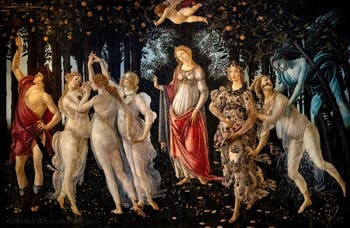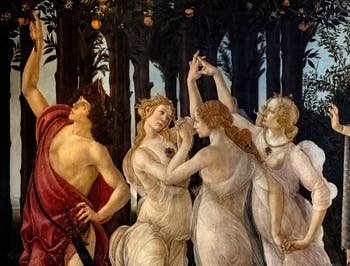Uffizi Artists | Location | Opening Hours Tickets | Authorizations
Artists Botticelli | Michelangelo | Da Vinci | Caravaggio | Raphael | Titian | Giorgione | Medici | Dürer Cranach Memling | Credi Bartolomeo | Rubens
Botticelli Spring | Venus | Pallas | Calumny | Judith | Augustine | Young Man | Magi Novella | Magi (1500) | Annunciation Cestello | Annunciation Martino | Madonna Pomegranate | Coronation Virgin | Madonna Magnificat | Madonna Enthroned | Madonna Glory | Madonna Rose | Madonna Saints
Botticelli “An Allegory of Spring” at the Uffizi Gallery in Florence

Allegory of Spring Tempera on wood (203 x 314 cm) 1481-1482
The central character is Venus in his sacred garden.
Venus who, instead of glorifying the carnal nature of pagan love, celebrates here the humanistic ideal of spiritual love.
The Spring painting is a cosmological and spiritual representation of the universal cycle.
Venus represents the spiritual activities of man, directing the joint thanksgiving that symbolize its operative movement.

Allegory of Spring Above Venus, Cupid is ready to throw an ardent arrow towards the three Graces united in a circular and graceful dance, blond and slender Graces, an idealized representation of feminine beauty in the 15th century.
The Zephyr wind creases into the folds of their light tunics, making them stick to their virgin shapes to better show their beauty.
On the left, the young naked man, covered in a simple red coat, wearing the sword and a military helmet, is none other than the God Mercury who keeps the sacred wood.
It is the symbol of reason and good advice, taking care of the harmonious completion of the cycle.

Allegory of Spring With the finger raised, he dissipates with the help of his own caduceus the clouds of passion and intemperance that should not disturb the eternal spring of the garden.
In the right part of the painting, advances a young smiling woman with clothes mixing fabrics and petals.
Her tunic is lined with flowers while a flowery garland wraps around her body.
In a fold of her tunic, she wears rose buds that she sows on her way.
Some of the buds bloom barely fallen to the ground, emphasizing the role of the goddess, responsible for bringing the fragrances and colours of spring.
This goddess is none other than Flora, goddess of youth and flowering, patron of agricultural work and protecting female fertility.

Allegory of Spring To his right, Zephyr, the west wind, messenger of the spring, is depicted winged and blue, we see him ready to seize the nymph Chloris, who runs terrorized before him.
In his race, the sails around him open and discover the beauty of his body while the crazy strands of her long hair fry her breasts.
From the fruitful encounter of Zephyr and Chloris are born buds that bloom continuously from his mouth.
Zephyr having taken Chloris for his wife, she is raised to the rank of a goddess, responsible for the flowering of all species of flowers.
This is how from nymph, it turns into the Latin divinity Flora.
The tale and poetry of Ovid are transposed here by Botticelli, claiming the beneficial action of the wind that carries the first seasonal glow through which the seedlings flourish.
Botticelli Spring | Venus | Pallas | Calumny | Judith | Augustine | Young Man | Magi Novella | Magi (1500) | Annunciation Cestello | Annunciation Martino | Madonna Pomegranate | Coronation Virgin | Madonna Magnificat | Madonna Enthroned | Madonna Glory | Madonna Rose | Madonna Saints
Artists Botticelli | Michelangelo | Da Vinci | Caravaggio | Raphael | Titian | Giorgione | Medici | Dürer Cranach Memling | Credi Bartolomeo | Rubens
Uffizi Artists | Location | Opening Hours Tickets | Authorizations
Back to Top of Page
















